Staying compliant in today’s fast-changing regulatory environment isn’t easy, especially when you’re juggling multiple frameworks, frequent audits, and ever-growing data security demands.
That’s why tools like Compliance AI have become popular, helping businesses monitor regulatory updates, assess risks, and stay on top of compliance tasks.
But while Compliance AI offers strong features, it’s not the only option on the market.
Some teams find it too specialized, others need broader governance, risk, and compliance GRC capabilities, and many are looking for a platform that integrates compliance management with their wider workflows.
The good news? If you’re exploring Compliance AI alternatives in 2025, you have more choices than ever, from all-in-one GRC platforms with built-in automation to agile tools that make regulatory tracking and policy management easier for smaller teams.
In this guide, I’ll compare the top Compliance AI competitors, breaking down their key features, pricing, pros, and cons, so you can easily find the right fit for your business.
TL;DR
- SmartSuite stands out as the top Compliance AI alternative in 2025 for its all-in-one GRC coverage, real-time collaboration, and no-code flexibility, helping teams centralize risk, compliance, and audit workflows without the complexity or hidden costs.
- Solutions like Hyperproof and LogicGate excel for growing teams that want to automate evidence collection, streamline frameworks, and customize workflows with ease.
- For enterprises needing deep, highly scalable GRC ecosystems, platforms like ServiceNow, Archer, and MetricStream deliver advanced risk orchestration, AI-powered insights, and integration across complex global operations.
Ready? Let’s dive in!
Why do you need Compliance AI alternatives in the first place?
Compliance AI certainly gets a few things right for highly regulated teams:
- AI-assisted regulatory change monitoring. It applies machine learning to track new rules and map them to internal policies, procedures, and controls, reducing manual review across levels.
- It’s purpose-built for financial services. The product is positioned for BFSI, with dashboards, topic libraries, and regular agency update feeds tailored to that audience.
Still, there are several reasons why teams consider an alternative:
1. Limited third-party reviews = harder due diligence
Public review coverage is thin.
For example, SoftwareSuggest shows 0 reviews on its Compliance.ai listing, and G2 surfaces an “alternatives” page but no direct feedback, making it tougher to validate UX, support, and ROI from peer data.

This can quickly become a major issue for heavily regulated organizations, as lack of valid social proof can raise quite a few questions and eyebrows.
2. Narrow industry focus
If you’re not in banking/financial services - or you need broad, cross-functional GRC beyond regulatory change (e.g., enterprise risk, audits, vendor risk) - a wider GRC platform may fit better.
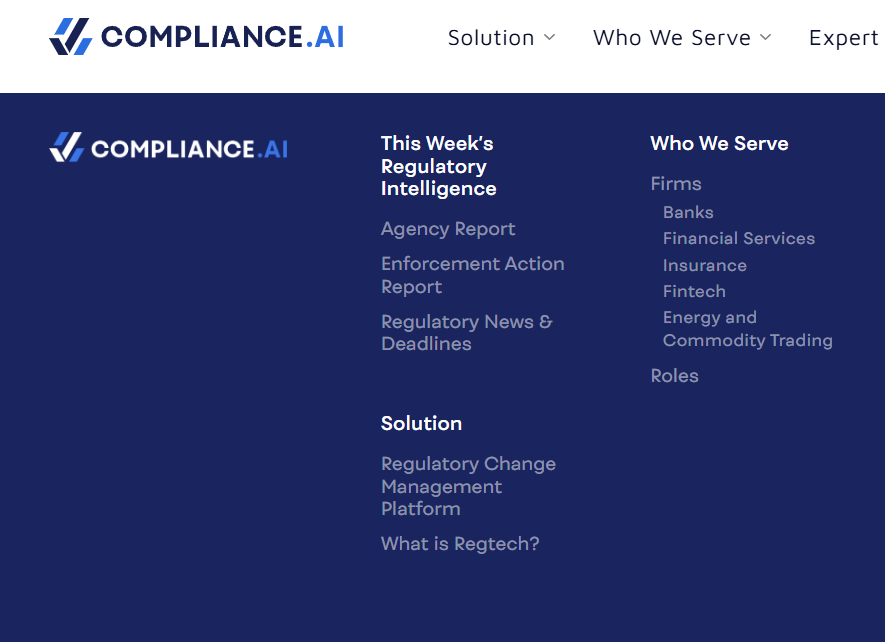
Compliance AI is designed solely for the financial sectors, so if you’re looking for broader risk coverage and management, you’ll definitely need an alternative.
3. Opaque pricing
When evaluating a GRC platform - or any software solution - one of the key factors to consider is the price.
Compliance AI doesn’t publish any details about its pricing, including things like the pricing tiers they offer, the features each includes, etc.
The only thing you can do is book a demo and ask for more information on the spot.
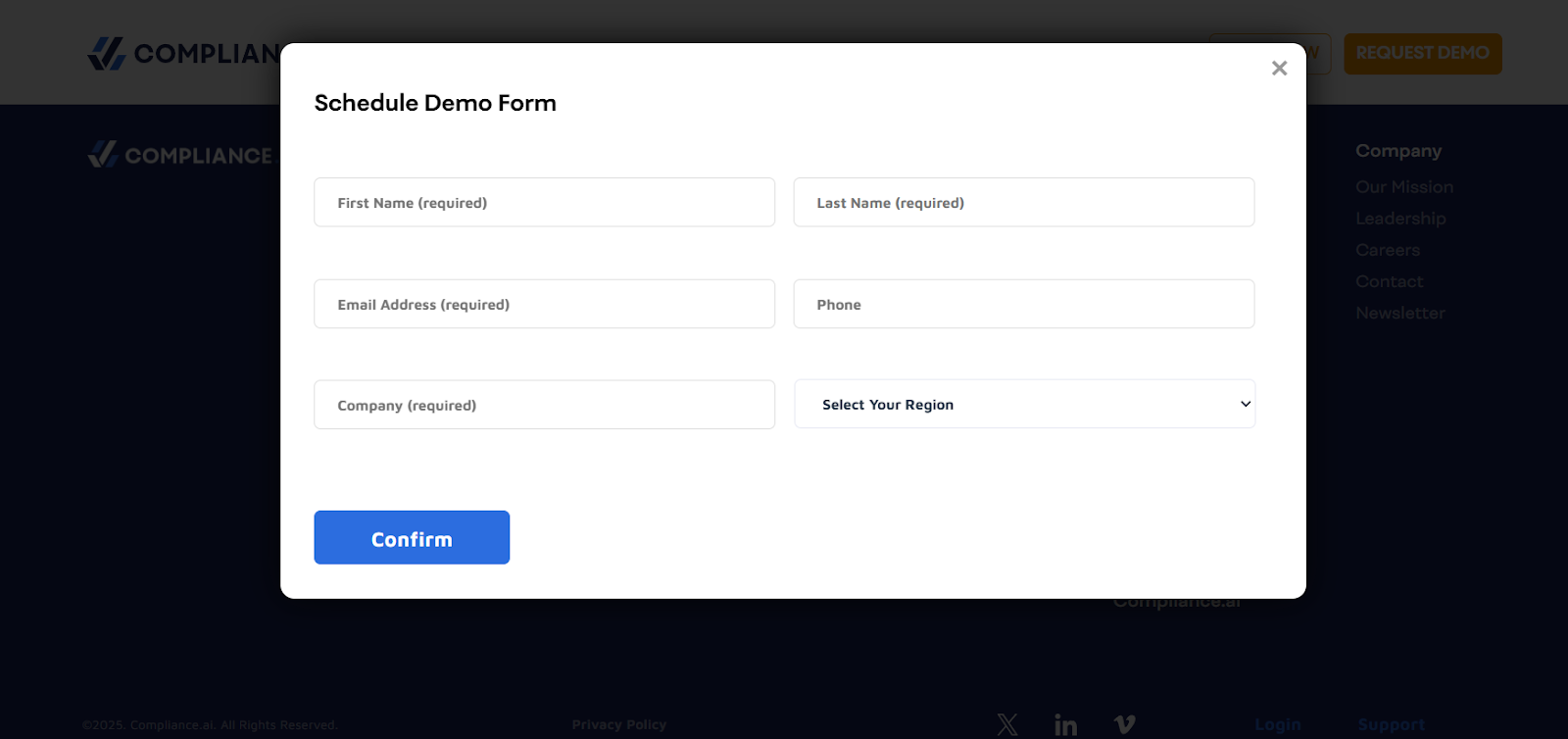
This approach usually indicates that the platform is on the higher end of the pricing range.
What are the best Compliance AI alternatives and competitors in 2025?
And now, let’s look at the top 10 Compliance AI alternatives for GRC in 2025, based on their overall capabilities, UX, and customer reviews:
- SmartSuite - An all-in-one, no-code workspace that lets teams manage regulatory change, policy, risk, and audit workflows fast with templates, automations, and interactive dashboards.
- AuditBoard - A modern audit, risk, and compliance platform with strong, user-friendly workflows and new regulatory-change capabilities (powered by CUBE data) that bring AI into day-to-day compliance work.
- Hyperproof - A “compliance operations” hub built to automate controls, orchestrate evidence, and monitor program health so teams are always audit-ready.
- LogicGate Risk Cloud - A flexible, no-code GRC platform that excels at automating evidence collection and compliance workflows while giving real-time risk and reporting insights.
- OneTrust - A broad GRC and trust platform known for “collect once, comply many” evidence reuse, 50+ frameworks, and 500+ pre-built integrations to scale compliance programs.
- ServiceNow GRC - Enterprise-grade, AI-enabled GRC that connects IT, security, and the business on one platform to automate workflows and deliver a real-time view of risk and compliance.
- MetricStream - A connected GRC suite with deep regulatory-compliance modules and marketplace integrations for regulatory content, security intel, third-party risk, and more.
- Archer - A mature integrated-risk platform that centralizes policies, controls, and assessments with expanding AI for regulatory intelligence and financial controls monitoring.
- IBM OpenPages - An AI-driven, highly scalable GRC solution that centralizes risk and regulatory compliance and continues to add automation and usability updates regularly.
- Diligent - A unified, AI-powered governance, audit, and compliance platform with templates, dashboards, and content to accelerate controls management and executive reporting.
1. SmartSuite
Best for: Teams of all sizes looking for a flexible, customizable, no-code GRC platform that can easily adapt to all kinds of workflows and organizational needs.

SmartSuite is a no-code, all-in-one GRC work-management platform designed to simplify even the most complex compliance programs.
It gives teams - whether they’re just starting out or running mature, multi-framework operations - a single place to track regulatory changes, manage policies, assess and mitigate risks, respond to incidents, oversee vendors, protect data privacy, and plan audits.
With its flexible, collaborative workspace, SmartSuite connects every GRC process so nothing falls through the cracks, while keeping all stakeholders aligned in real-time.
Let’s look at some of the features that make SmartSuite such a strong Compliance AI alternative.
1. Unified GRC platform, end-to-end
SmartSuite brings every major governance, risk, and compliance process into one connected workspace.
As a result, instead of juggling multiple tools, spreadsheets, or email threads, your entire program runs from a single source of truth.
Here’s how each area works and why it makes SmartSuite a stronger, broader choice than Compliance AI’s narrower regulatory focus:
- Contract management - Track every agreement (a sales contract, vendor agreement, regulatory requirement, etc.) from drafting and review to approval and renewal. Built-in reminders ensure you never miss an expiration or key obligation.
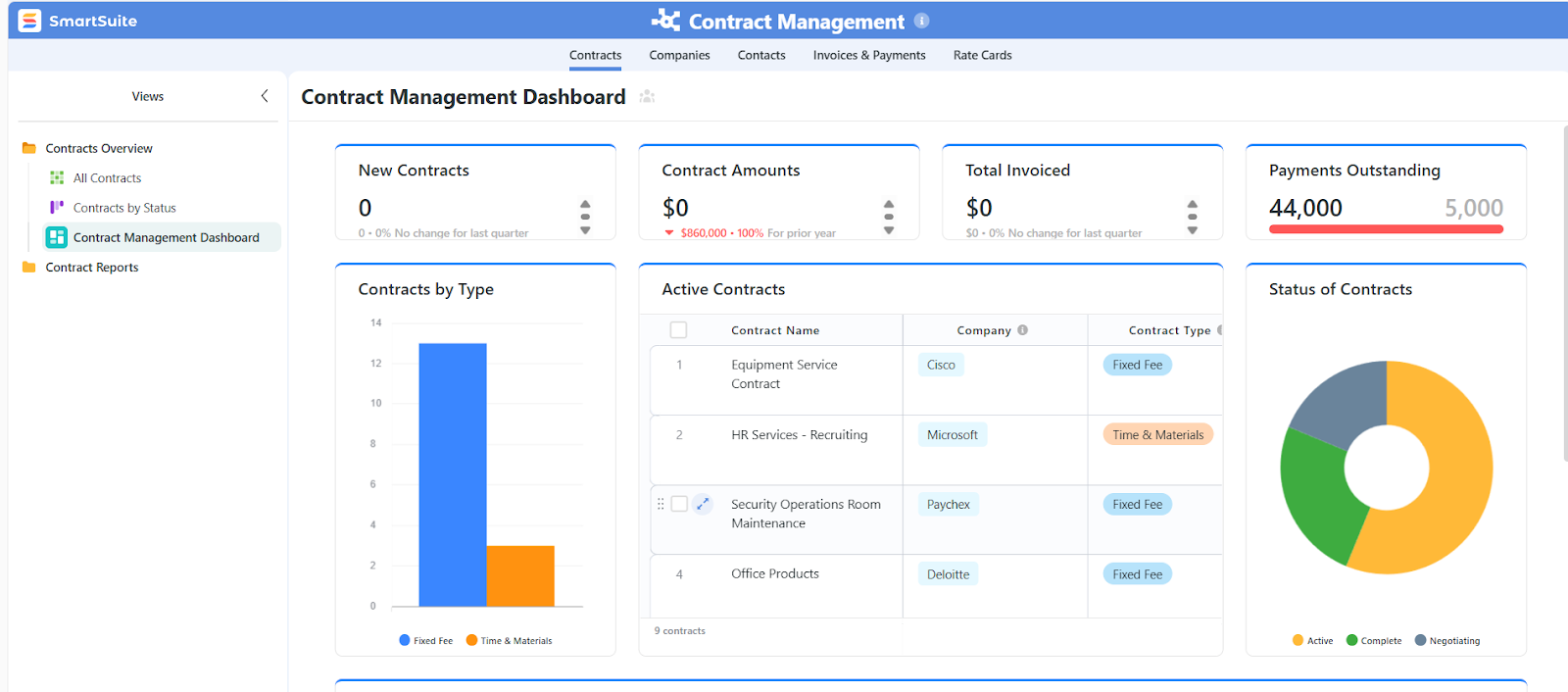
- Policy management - Create, review, and publish policies from a centralized hub. Assign ownership, manage revisions, and ensure every document stays aligned with business objectives and regulatory frameworks.

- Risk management & registers – Maintain a live risk register that identifies, assesses, and prioritizes threats. Link risks to controls, assign mitigation plans, and monitor KPIs to measure effectiveness over time.

- Task assignment and prioritization - Seamlessly assign critical tasks to team members best suited to handle them and set up automated workflows to ensure everything is carried out according to regulatory guidelines and your SOPs.
- Incident management - Log and categorize incidents in real time, assign them to the right responders, and track them to resolution. Automations escalate critical events instantly to keep teams alert.

- Powerful automation built-in - SmartSuite’s visual automation builder lets you eliminate repetitive work, automatically assigning tasks, sending alerts, updating records, and moving items through workflows when trigger conditions are met. This reduces the risk of human error and keeps every GRC process moving without manual chasing.
2. Real-time collaboration built into the process
SmartSuite keeps all your GRC communication and teamwork in one place - right inside the workflows where the work is happening.
Instead of bouncing between email, chat apps, and spreadsheets, your team can:
- Comment directly on records.
- Tag colleagues with @mentions to get their attention.
- Keep every discussion tied to the relevant policy, risk register entry, incident report, or audit plan.

This “collaborate where the work happens” approach means context is never lost, and decisions are always linked to the right documentation.
Moreover, granular access controls ensure sensitive compliance data stays protected.
You can set permissions by role, team, or individual so only the right people can view or edit each record, keeping regulators happy while still enabling fast, informed decision-making.
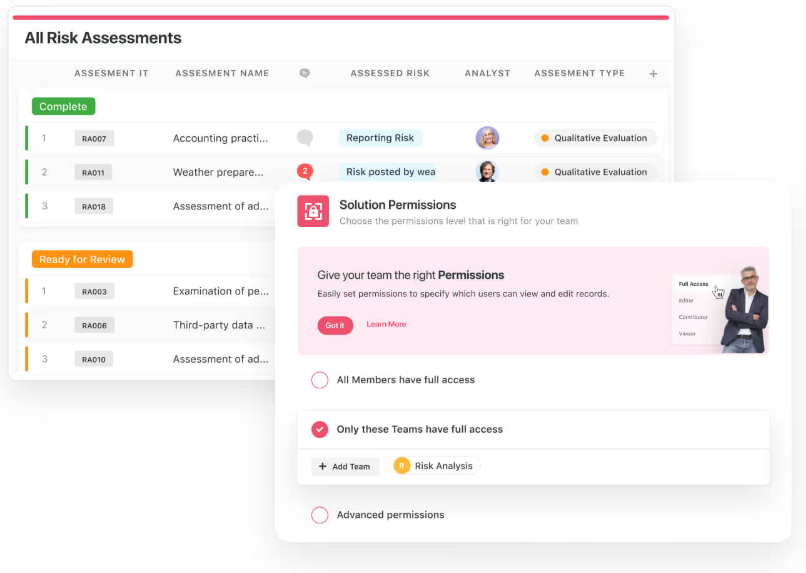
Then, there are real-time updates that mean multiple people can work on the same record simultaneously and instantly see changes as they happen, which is perfect for joint policy reviews, coordinated incident responses, or team-based audit prep.
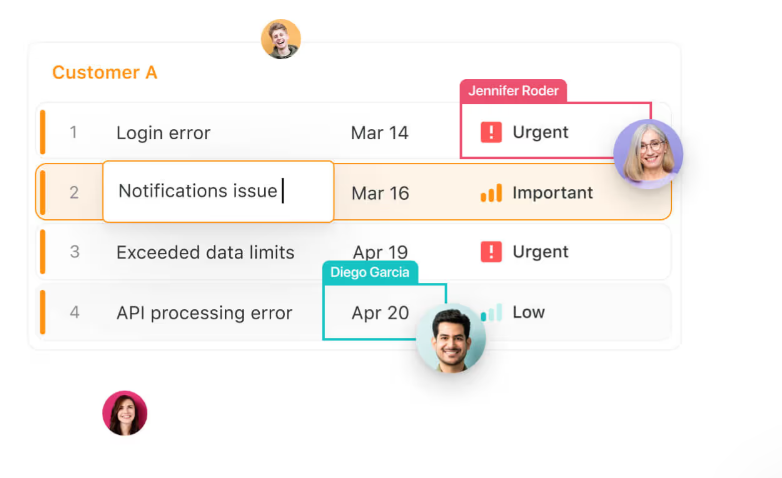
And if you urgently need to find a piece of information somewhere across tables, contracts, and spreadsheets?
SmartSuite’s Power Search lets you find anything you need within seconds, without having to manually sift through every digital space you own.

Finally, activity history provides a complete log of edits, comments, and assignments, so you always know who did what and when.

With SmartSuite, collaboration isn’t an afterthought.
It’s built directly into your compliance processes, making it easier to stay aligned, move faster, and keep every stakeholder in the loop.
3. Highly customizable and adaptable
No two organizations run their compliance programs the same way, which is why SmartSuite is designed to flex around your needs instead of forcing you into a fixed framework.
You can capture and organize exactly the information that matters to you, using over 40 field types to structure everything from regulatory references and control IDs to vendor ratings and audit findings.
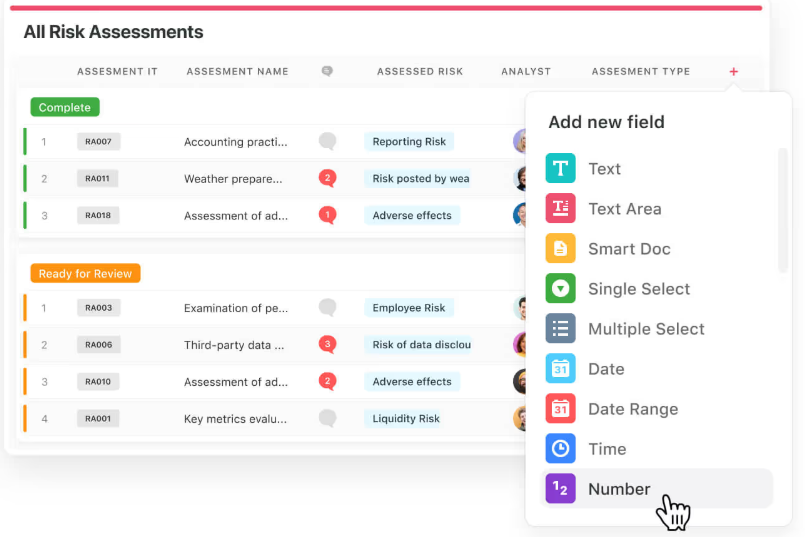
That data then comes to life in fully configurable dashboards, giving you a real-time view of your compliance posture, and in drag-and-drop reports that make sharing insights with executives, auditors, or regulators effortless.

And because every business measures risk differently, SmartSuite lets you define your own metrics, build custom calculations to generate risk scores and monitor the indicators that align with your priorities.
Those scores are instantly surfaced in dynamic dashboards, so spotting trends, flagging emerging risks, and prioritizing response efforts becomes part of your everyday workflow.
And since all of this connects seamlessly with your existing systems via native integrations, Zapier, and a robust REST API, you can:
- Pull in data from across the business.
- Link it directly to your GRC processes.
- Scale or refine your workflows as your compliance needs evolve without heavy IT lift.
4. Ready-made, fully customizable templates
SmartSuite helps you get started within minutes with a library of live, interactive templates built for core GRC activities.

These aren’t static forms, as you can easily adapt them to match your organization’s processes.
Each template is fully editable, so you can add fields, adjust workflows, and tailor reports without starting from scratch.
A few examples include:

- Policy Management - Centralizes policy creation, review, approval, and publication so your workforce always has access to the latest, compliant procedures.
- Incident Management - Tracks incidents from identification to resolution, assigning tasks, setting deadlines, and logging corrective actions along the way.
- Risk Management - Creates a living risk register to identify, assess, and prioritize risks, complete with mitigation plans and ongoing monitoring.
- Third-Party Risk - Consolidates vendor information, manages due diligence, and automates periodic reviews to keep your supply chain and partners compliant.
- Regulatory Change Management - Monitors updates to relevant laws and frameworks, assigns review tasks, and ensures timely policy or control adjustments.
- Vulnerability Management - Helps protect sensitive data from unauthorized use or theft.
By starting with these ready-made templates, you skip weeks of setup and move straight into running your compliance program, while still keeping the flexibility to customize every detail to your unique requirements.
Try one on for size right now to get a good grasp of how intuitive and interactive SmartSuite’s templates are.
Pricing
Unlike Compliance AI, SmartSuite has transparent pricing with no hidden costs.
Firstly, it has a free forever plan that provides access to its templates, dynamic dashboards, team collaboration features, 100 monthly automations, etc, making it ideal for small teams testing the waters.
And if you need more features, you can subscribe to one of four paid plans:
- Team: $12/user/mo, includes everything in Free, plus unlimited users, Gantt charts, 5,000 automation runs, etc.
- Professional: $30/user/mo, includes everything in Team, plus two-factor authentication, Gmail & Outlook integrations, AI features, more automation runs, etc.
- Enterprise: $45/user/mo, includes everything in Professional and adds audit logs, data loss prevention, 50,000 monthly API calls, etc.
- Signature: A customized plan tailored to your organization’s needs and team size with no predefined limits.

The first three paid plans have a 14-day free trial - no credit card needed.
How does SmartSuite compare to Compliance AI?
While both platforms help organizations stay on top of compliance requirements, they serve different needs and audiences. Here’s how they stack up:
- Scope of coverage - Compliance AI is primarily focused on regulatory change monitoring, especially for banking, financial services, and insurance (BFSI) industries. SmartSuite, on the other hand, covers the entire GRC lifecycle across any industry.
- Industry focus - While Compliance AI is built for highly regulated financial sectors and as such is less applicable to non-BFSI organizations, SmartSuite is industry-agnostic, with flexible templates and workflows for finance, healthcare, tech, manufacturing, and more.
- Collaboration - Compliance AI offers team workflows but collaboration features are secondary to regulatory intelligence. SmartSuite has real-time collaboration built-in, so discussions happen directly where work is done.
- Customization & flexibility - Compliance AI has a fixed feature set tied to its regulatory data, with limited customization outside its core focus. At the same time, SmartSuite offers no-code customization with over 40 field types, custom dashboards, automation builder, and API/Zapier integrations for adapting to unique processes.
- Pricing - Compliance AI doesn’t have public pricing; it’s quote-only, often signaling higher cost. SmartSuite has completely transparent pricing with a free plan, paid tiers starting at $12/user/month, and a 14-day free trial.
So, in the end, if your sole focus is BFSI regulatory change tracking, Compliance AI offers targeted expertise.
But for organizations seeking an all-in-one, customizable, and collaborative GRC platform that scales across industries, SmartSuite delivers far greater flexibility and value.
Pros & Cons
✅ Unites every governance, risk, and compliance process in a single platform, eliminating the need for multiple tools.
✅ No-code customization with over 40 field types, drag-and-drop reports, and dynamic dashboards, which make it easy to tailor workflows without IT help.
✅ Transparent pricing with a free forever plan and free trials.
✅ Industry-agnostic, meaning it works for any sector, not just financial services.
✅ Real-time collaboration, including comments, @mentions, activity history, and shared editing keep teams aligned without switching between apps.
✅ Prebuilt, editable templates let you jumpstart programs for essential GRC workflows.
❌ Limited native integrations compared to some enterprise solutions.
2. AuditBoard
Best for: Mid-market and enterprise teams that want a modern, connected platform for audits, SOX/internal controls, enterprise risk, and IT/security compliance.
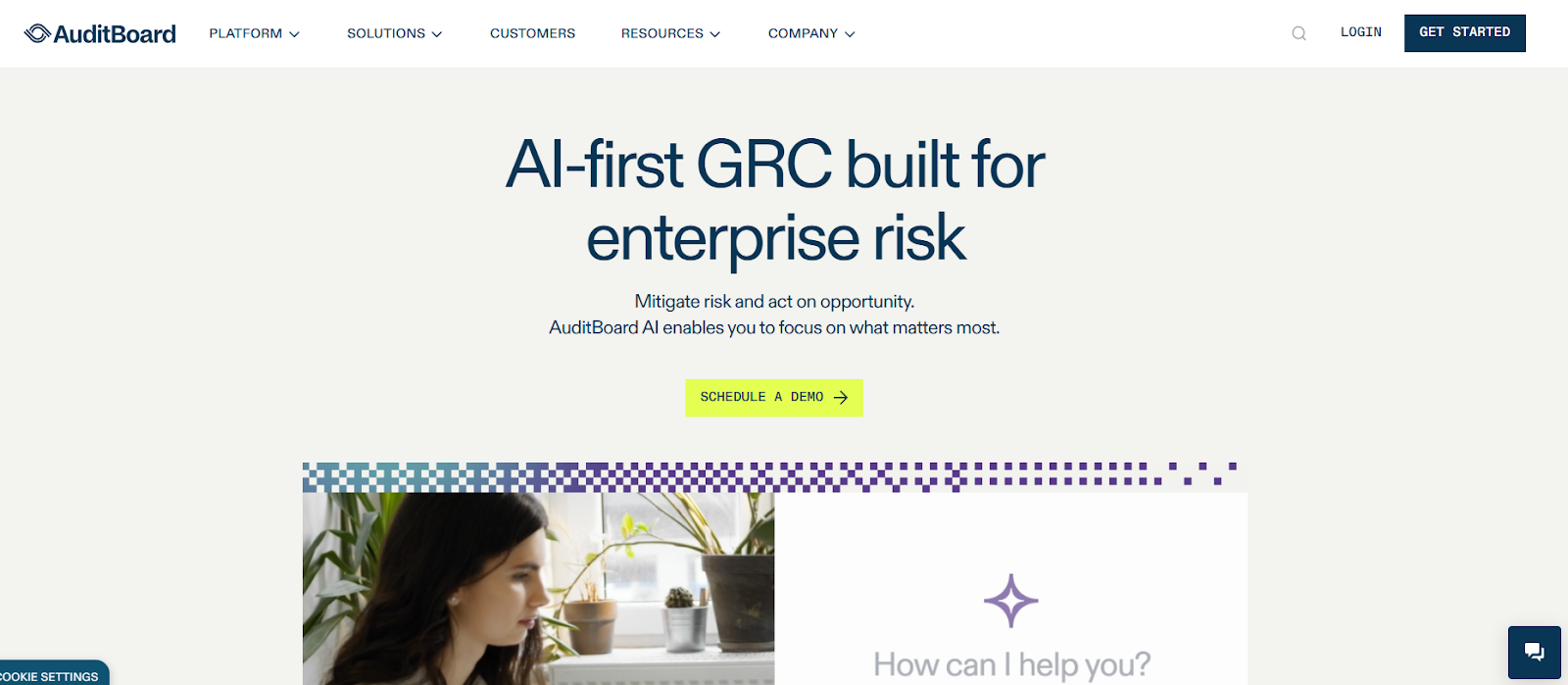
AuditBoard is a connected risk platform that unifies audit, risk, and compliance programs in one place.
This year, it added a regulatory compliance solution powered by CUBE’s RegPlatform data and new AI capabilities to streamline change monitoring and execution.
Key features
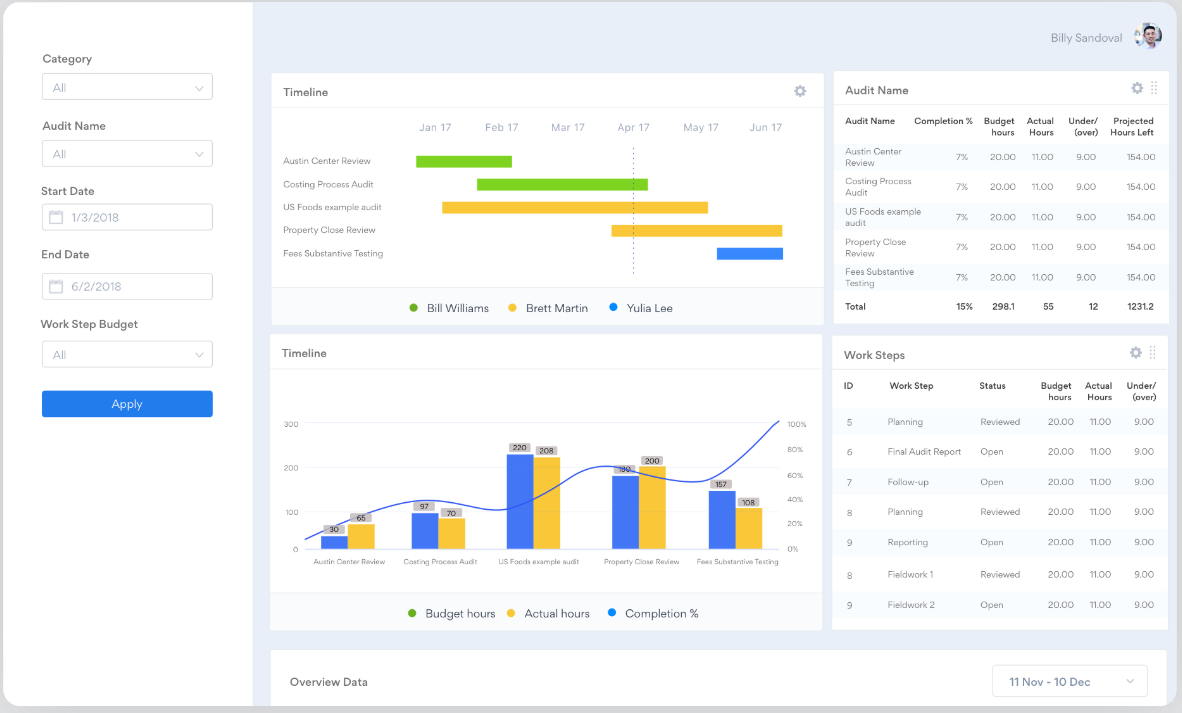
- Comprehensive audit management - Plan audits, test controls, manage issues, and report faster with workflows purpose-built “by auditors, for auditors.”
- Regulatory change management - New RegComply capabilities use CUBE’s regulatory intelligence to track obligations and keep requirements current.
- AI & analytics - AuditBoard AI helps draft, summarize, de-duplicate issues/evidence, and recommend mappings between risks, controls, and requirements.
Pricing
AuditBoard doesn’t publish pricing details.
You can schedule a demo to see the platform in action and inquire about the price.

Pros & Cons
✅ User-friendly, highly rated UI that centralizes documentation and improves collaboration.
✅ Broad, connected scope unifying audit, SOX, ERM, compliance, TPRM, reducing silos and tool sprawl.
❌ Steep learning curve.
3. Hyperproof
Best for: Compliance, risk, and security teams in mid-sized to enterprise organizations seeking a cloud-based platform that keeps them audit-ready through continuous compliance, streamlined evidence collection, and broad framework support.
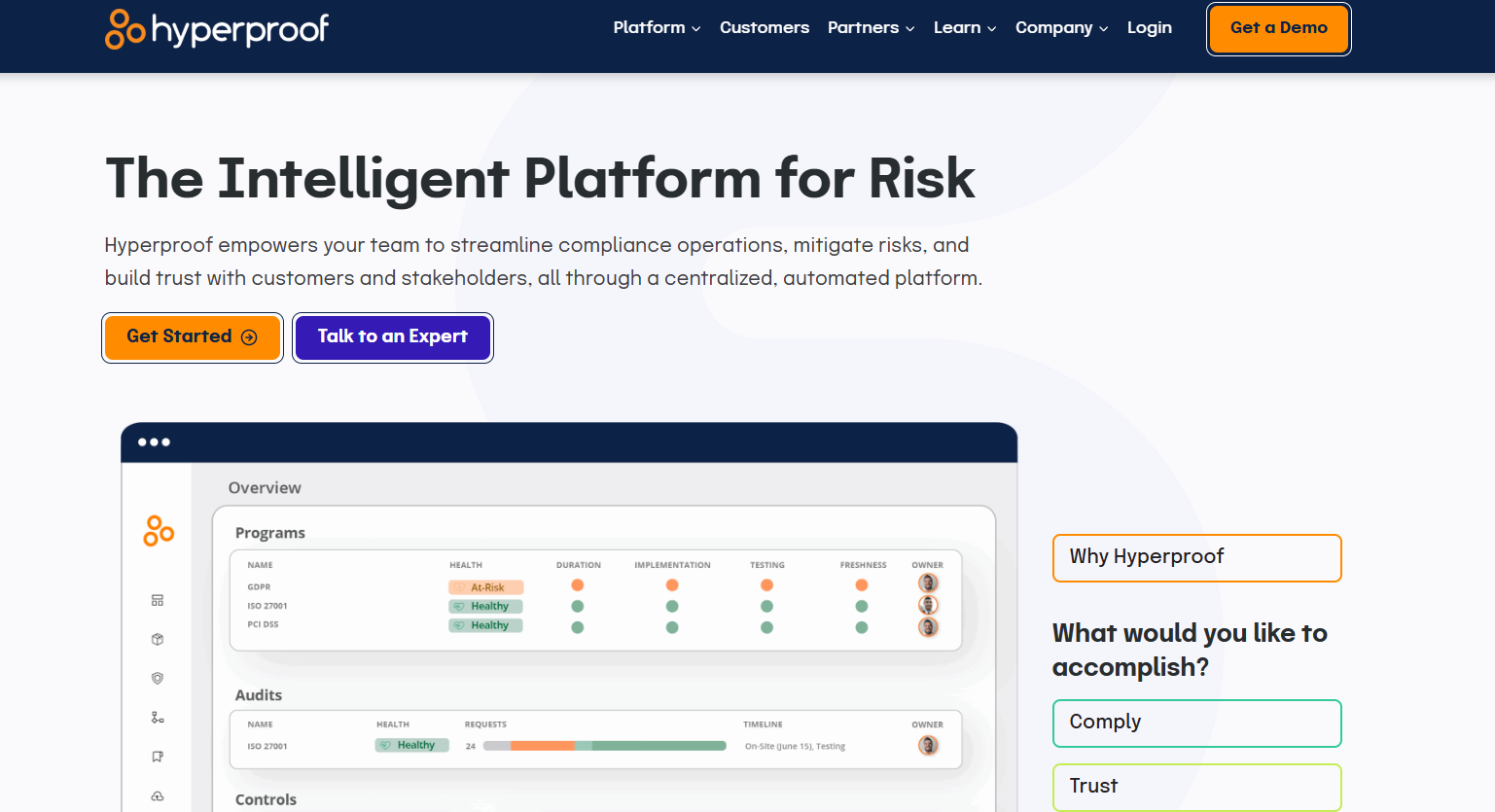
Hyperproof is a compliance operations platform designed to help teams manage, track, and automate day-to-day GRC activities with real-time visibility and task automation.
It supports over 100 frameworks and offers rich integrations to centralize evidence, tasks, and compliance tracking.
Key features

- Evidence collection & framework management - Automates evidence tracking and lets you run multiple frameworks like SOC 2, ISO, NIST, PCI DSS, HIPAA, and GDPR in one place.
- Real-time compliance dashboards - Centralized dashboards offer an always-updated view into audit preparedness and control effectiveness.
- Task automation & reminders - Built-in workflows and reminders keep tasks moving forward continuously between audit cycles.
Pricing
Similar to many GRC platforms, Hyperproof doesn’t disclose its pricing.
You can book a demo and ask for a custom quote.

Or, take a look at our in-depth Hyperproof pricing review, and find everything you need to assess its value for money.
Pros & Cons
✅ Powerful automated evidence collection helps streamline workflows and reduce manual effort.
✅ Centralizes all frameworks, controls, and evidence in a single platform.
❌ Dashboards and reporting features offer limited customization options.
4. LogicGate
Best for: Mid-sized to large organizations that want a highly customizable, no-code GRC platform capable of scaling with their maturity level and adapting to unique workflows.
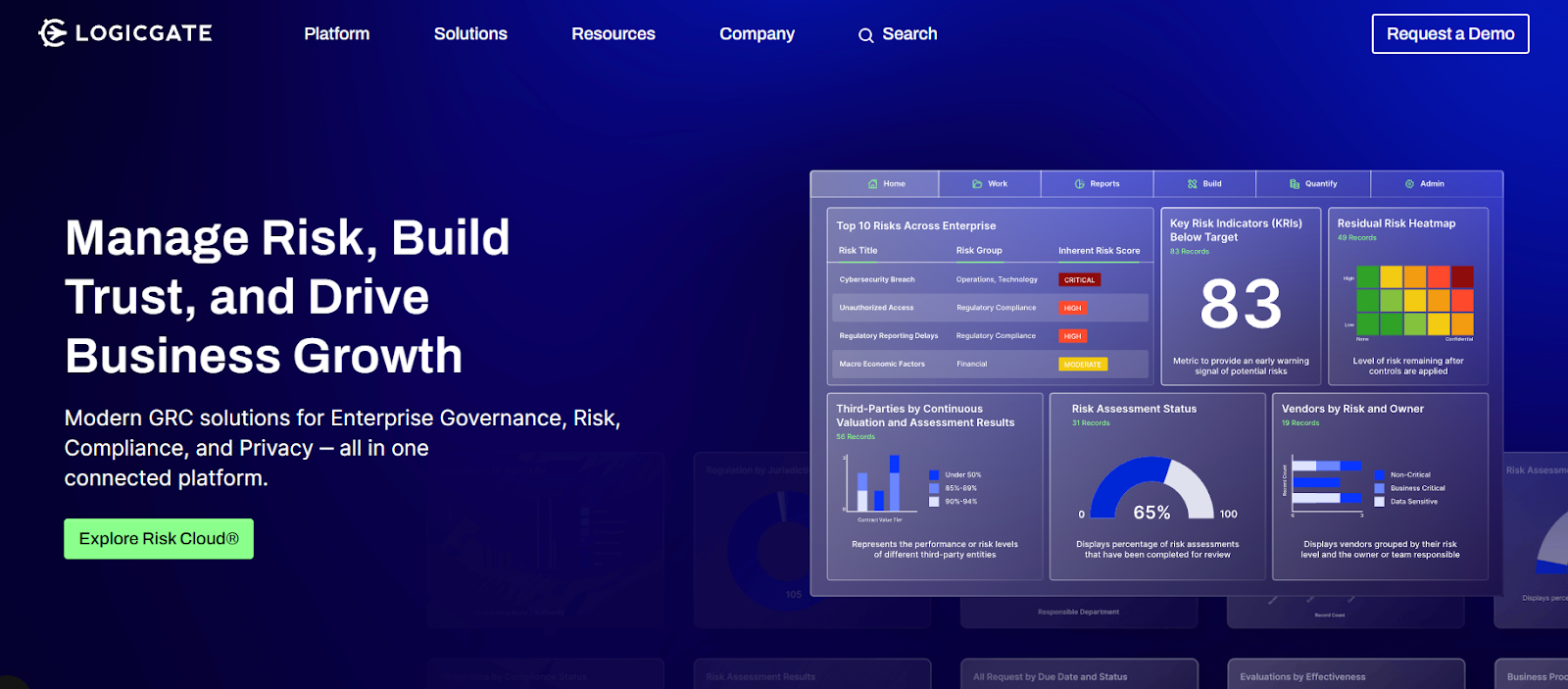
LogicGate is a flexible no-code GRC platform built around customizable workflows, visual logic, and enterprise risk insights, designed to adapt to each organization’s processes.
It combines modular applications with automation, intelligent dashboards, and a centralized view of risks, controls, and assets.
Key features
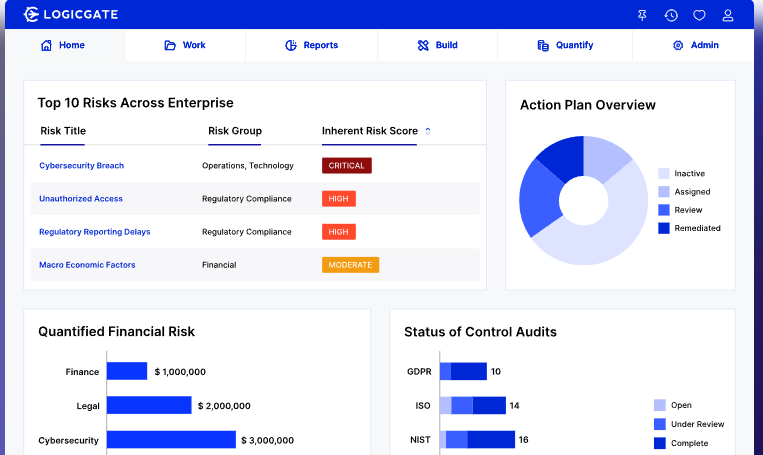
- Custom workflow builder - Drag-and-drop tools let you design tailored risk and compliance workflows without coding.
- No-code graph database & dashboards - View interconnected risks, controls, incidents, and assets in real-time, paired with customizable dashboards for quick insights.
- Risk quantification tool - Translate risks into financial impact using built-in value models to help decision-makers prioritize effectively.
Pricing
LogicGate uses a custom pricing model tailored to your organization’s size, GRC maturity, and specific use cases, so you only pay for what you need.
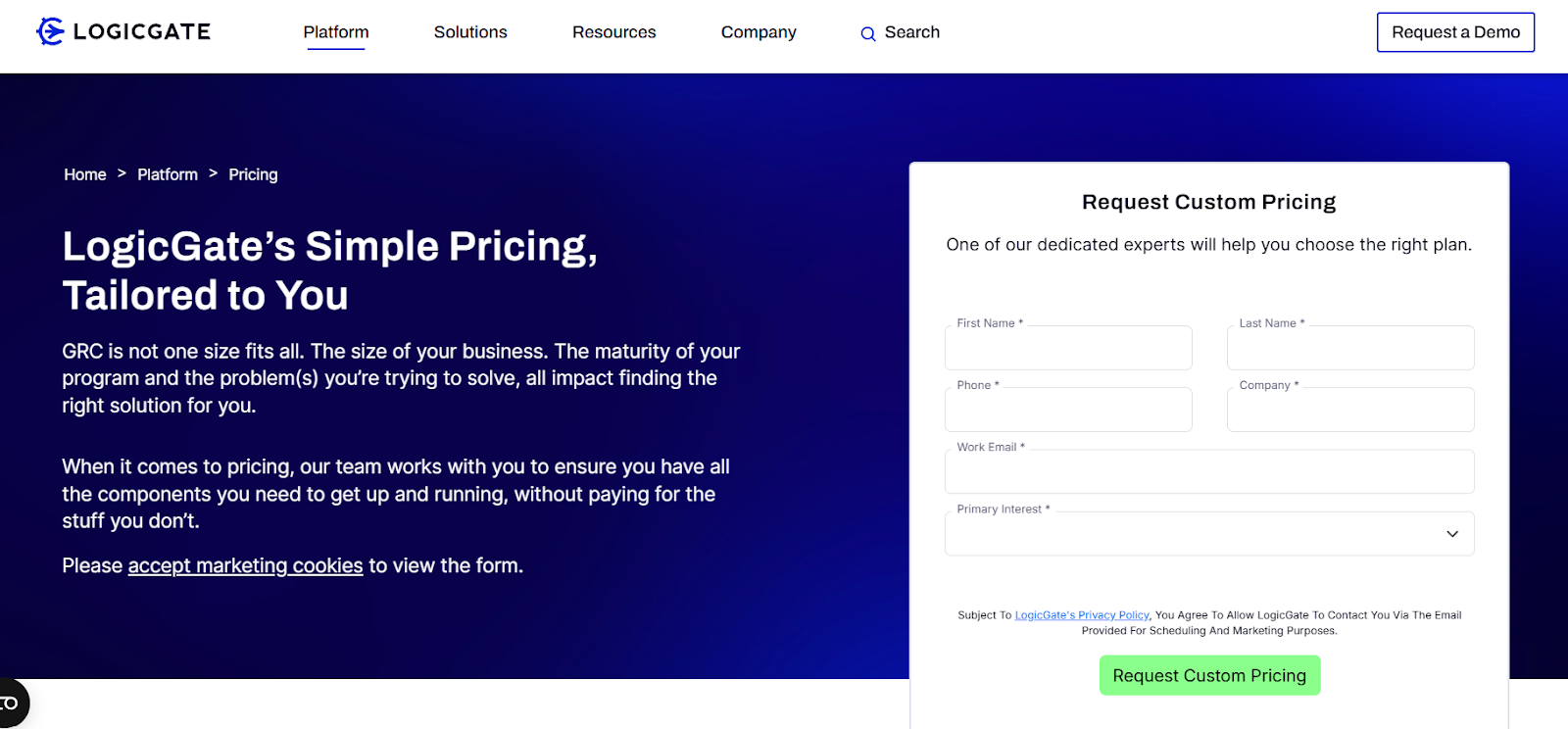
Costs are based on:
- Applications - Choose from 30+ modular GRC apps (e.g., policy management, vendor risk, incident response) and pay only for the ones you use.
- Power Users - Licenses for the people building and managing your GRC program, not your entire organization.
- Add-ons - Optional advanced features like Risk Cloud Quantify™, additional product modules, and integrations.
- Services - Implementation, professional services, and integration support available as needed.
Pricing is provided on request after a consultation with their team.
For more information, check out our LogicGate’s pricing guide.
Pros & Cons
✅ Highly customizable, allowing you to tailor workflows and adapt the platform to any industry use case.
✅ Intuitive interface, very easy to navigate.
❌ Users report issues with automated evidence collection.
5. OneTrust
Best for: Enterprises and global teams prioritizing data privacy, third-party risk, AI governance, and consent management, especially those needing automation across extensive regulatory frameworks.

OneTrust is an enterprise-grade GRC and trust platform that brings together consent and preference management, privacy automation, AI governance, third-party and technology risk, and regulatory compliance in a single solution.
It’s designed to help organizations stay compliant, manage risk, and innovate at scale in a responsible way.
Key features

- Privacy automation - Automate privacy workflows like Data Protection Impact Assessments (DPIAs), DSAR handling, vendor risk reviews, and breach response.
- AI governance - Centrally manage AI models, datasets, and compliance workflows to align with global standards and internal policies.
- Tech risk & compliance - Lets you use AI-powered compliance automation and continuous monitoring across multiple frameworks that enables a “collect once, comply many” model.
Pricing
OneTrust has several major product packages, some of which have more than one tier:
- Consent & Preferences:
- Consent Management Platform: Pricing based on average daily visitors aggregated across all channels and properties.
- Universal Consent & Preference Management: Pricing based on total data subject profiles captured.
- Privacy Automation (Pricing based on users and privacy asset inventory for both plans):
- Base.
- Suite.
- Third-Party Risk Management (Pricing based on admin users and third-party inventory for both plans):
- Base.
- Suite.
- Tech Risk & Compliance: Pricing based on admin users and asset inventory.
- AI Governance: Pricing based on admin users and AI inventory.

There are no prices disclosed for any of the plans, so you’ll have to contact its sales team or look into this in-depth OneTrust pricing guide.
Pros & Cons
✅ Wide coverage of relevant global regulation.
✅ Robust automation features.
❌ Complex setup and learning curve.
6. ServiceNow GRC
Best for: Large enterprises that already use or plan to expand on ServiceNow’s platform, especially those needing deeply integrated GRC, IT, security, and service workflows within one environment.

ServiceNow GRC is a comprehensive Governance, Risk, and Compliance suite built on the broader ServiceNow AI and workflow platform.
It delivers real-time risk visibility, automated controls, and cross-department resilience across policy, audit, vendor risk, privacy, and business continuity.
Key features
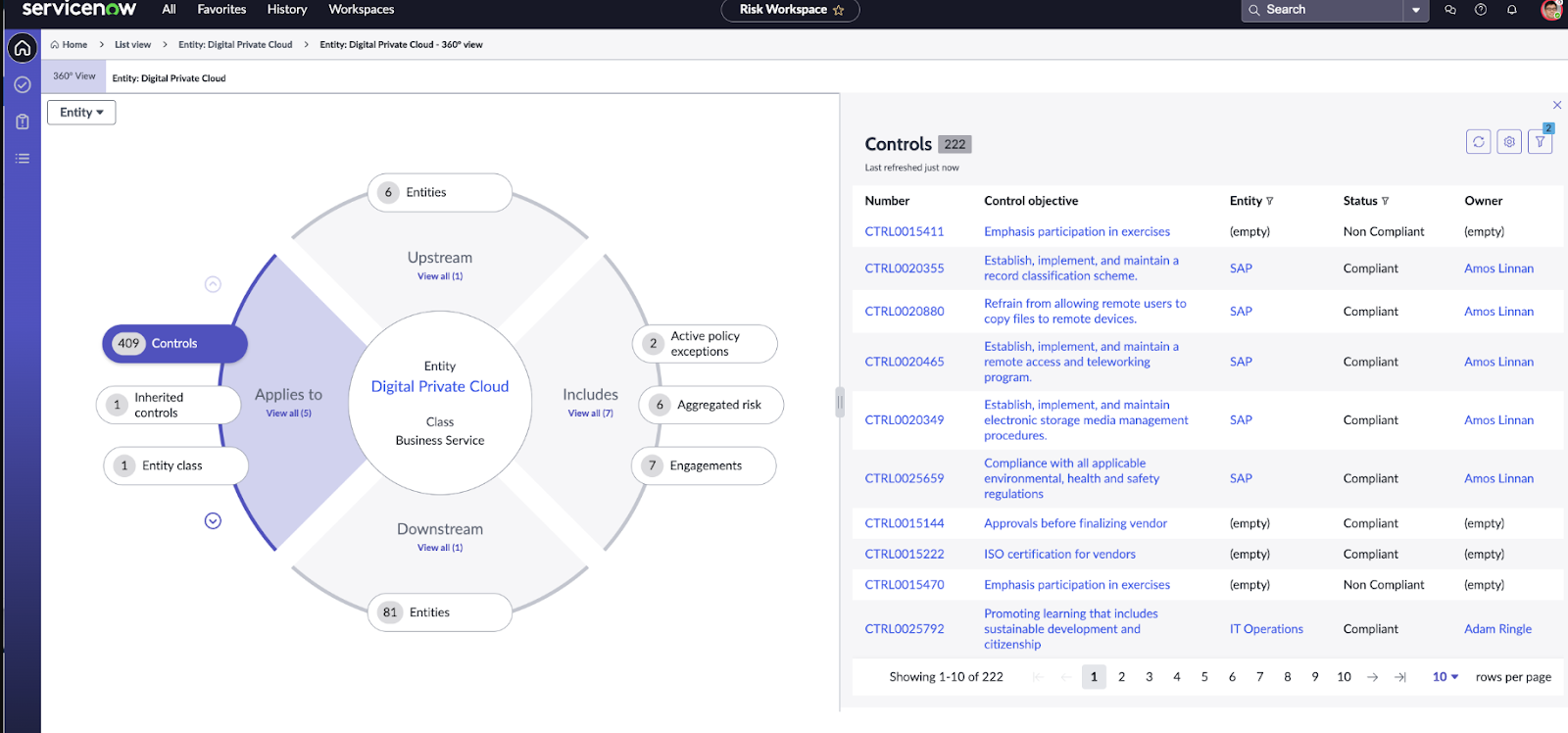
- Integrated risk management - Unifies policy and compliance management, audit tracking, operational risk, and regulatory change monitoring within a single framework.
- Workflow automation & AI - Powerful AI capabilities enable no-code automation, intelligent workflows, and actionable insights powered by shared data models.
- Cross-functional integration - Seamlessly integrates with ServiceNow modules such as ITSM, SecOps, HR, and Security Operations to unify risk and compliance data across silos.
Pricing
ServiceNow GRC doesn’t disclose its prices.
You’ll have to contact sales for more information or check our in-depth guide on its pricing.

Pros & Cons
✅ Holistic integration with enterprise workflows, tying GRC to IT operations, security, HR, and more on one platform.
✅ Real-time dashboards and continuous monitoring give leaders a clear, updated view of risk and compliance posture.
❌ Unintuitive interface and steep learning curve.
7. MetricStream
Best for: Enterprise-level organizations with mature GRC programs needing a deeply integrated, scalable platform across risk, audit, compliance, cyber GRC, third-party risk, and resilience.

MetricStream offers a comprehensive, AI-first ConnectedGRC platform that unifies all GRC functions into one intelligent system.
It empowers organizations to gain proactive, enterprise-wide visibility with AI-powered insights and continuous monitoring.
Key features

- AI-powered insights - Leverage AI for control insights, continuous monitoring, regulatory alerts, impact analysis, and natural-language policy searches.
- Continuous control monitoring & predictive analytics - Automate evidence gathering at scale, surface real-time risk metrics, and enable forward-looking GRC with dashboards and heatmaps.
- Robust reporting and analytics - Comprehensive built-in analytical dashboards & reports with rich visualizations for real-time insights.
Pricing
MetricStream doesn’t disclose its prices, meaning you’ll have to request a quote from its team.

Or, check out our in-depth MetricStream pricing review for quick access to all the information you need.
Pros & Cons
✅ Brings multiple GRC functions (risk, compliance, audit, cyber) into one unified platform.
✅ Powerful AI-driven automation.
❌ Limited reporting features.
8. Archer
Best for: Large enterprises that need a highly configurable, enterprise‑grade GRC platform to unify audit, risk, compliance, IT/cyber risk, third‑party governance, resilience, ESG, and regulatory programs across complex organizations.

Archer is an IRM platform that brings policies, controls, risks, assessments, incidents, and resilience functions into one system with AI-powered regulatory and operational insights.
Its configurability and long-standing adoption make it a staple for sophisticated GRC programs.
Key features
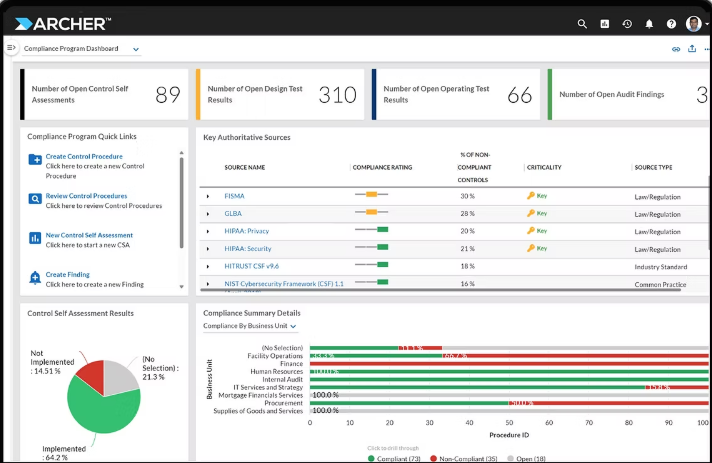
- AI‑powered insights - Use AI to monitor regulatory changes, detect incidents, analyze losses, and recommend control adjustments.
- Configurable risk taxonomy & workflows - Build your governance framework using pre-designed workflows, templates, and a rich risk taxonomy to align with enterprise practices.
- Advanced analytics & reporting - Drill into dashboards, loss scenarios, risk simulations, assessments, and customizable reports to inform executive decisions.
Pricing
Archer is yet another platform that opted against making its pricing information public.
You can contact its team and request a custom quote.
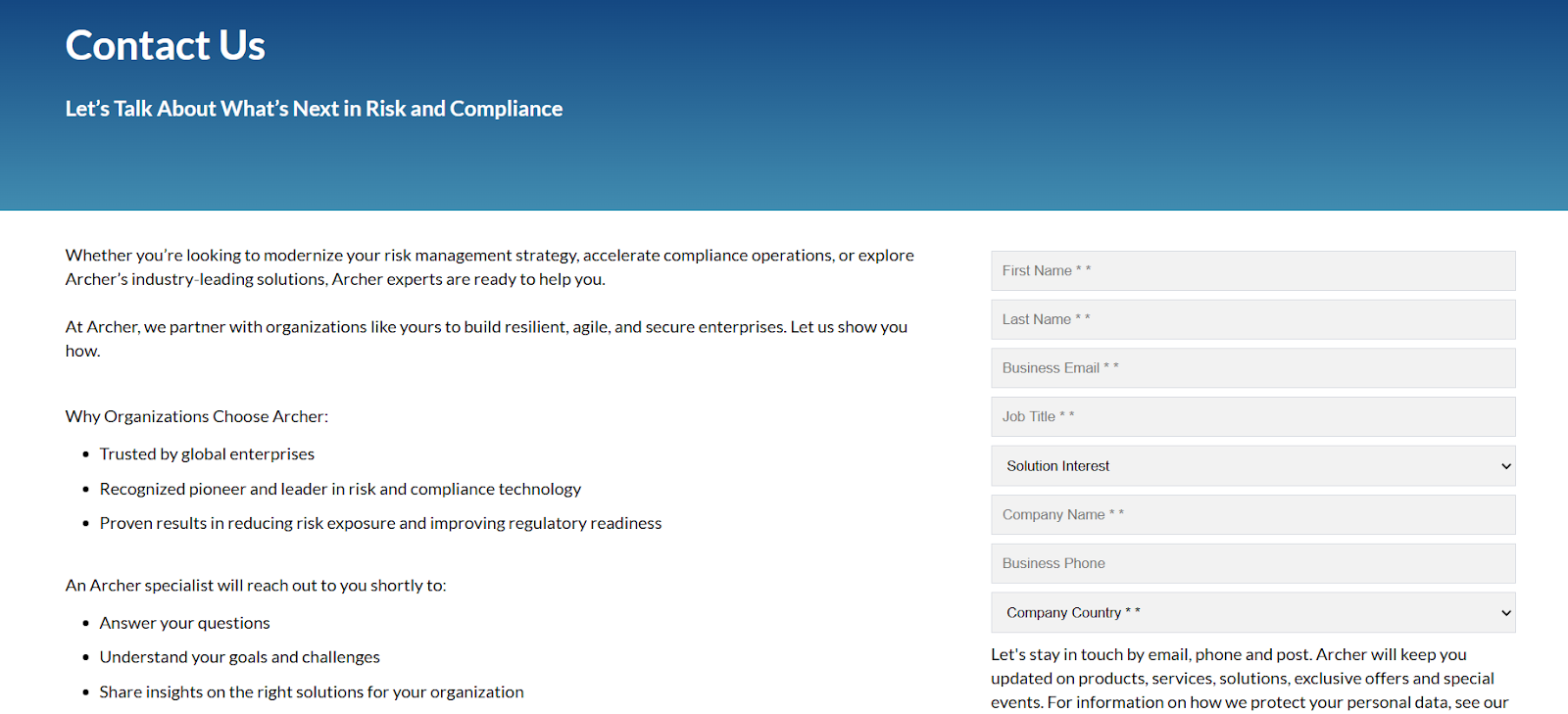
And if you want to avoid going back and forth with Archer’s team, this detailed Archer pricing review will explain all you need to know about its value for money.
Pros & Cons
✅ Flexible and powerful analytics dashboards let you drill down to important metrics easily.
✅ Highly customizable workflows.
❌ Unintuitive design and steep learning curve.
9. IBM OpenPages
Best for: Large enterprises and regulated organizations that need a scalable, AI-augmented GRC platform to unify risk, compliance, audit, IT governance, third-party risk, and business continuity across their operations.

IBM OpenPages is an AI-driven, highly scalable GRC solution that runs on any cloud (via IBM Cloud Pak for Data) or as SaaS, centralizing risk and compliance functions across the enterprise.
It combines embedded AI, configurable workflows, and advanced analytics to streamline governance, risk, and regulatory management.
Key features

- AI-enhanced insights - Leverages Watson AI and natural-language processing to provide embedded guidance, predictive risk insights, and intelligent automation across GRC tasks.
- Powerful analytics via Cognos - Comes bundled with IBM Cognos for rich, self-service data exploration, dashboards, and executive reporting.
- Configurable automation capabilities - Supports drag-and-drop workflow design and calculation engines to reduce manual overhead and accelerate time to value.
Pricing
There are several ways to purchase IBM OpenPages solution:
- As a SaaS solution: Essentials Edition starts at $3,300 and the Standard one starts at $6,050.
- As an On-cloud solution: Single Solution starts at $6,250 and the Enterprise one starts at $9,000.
- As part of IBM Cloud Pak for Data: Single Solution starts at $162,000 and Solution Bundle starts at $207,000.
- As On-Premises: You need to contact its team for a quote.

Regardless of which package you choose in the end, each will include a core set of IBM OpenPages features, such as its AI features, workflow automation, integrated reports, etc.
If you’re looking to understand what IBM OpenPages might cost your organization - and see whether its features justify the investment - check out our in-depth IBM OpenPages pricing guide.
Pros & Cons
✅ Robust AI features deeply integrated with the platform.
✅ Highly customizable.
❌ Cost-prohibitive for smaller and mid-sized organizations.
10. Diligent
Best for: Compliance, risk, and audit teams in mid-market to enterprise organizations seeking a centralized, automation-forward GRC solution with integrated dashboards.
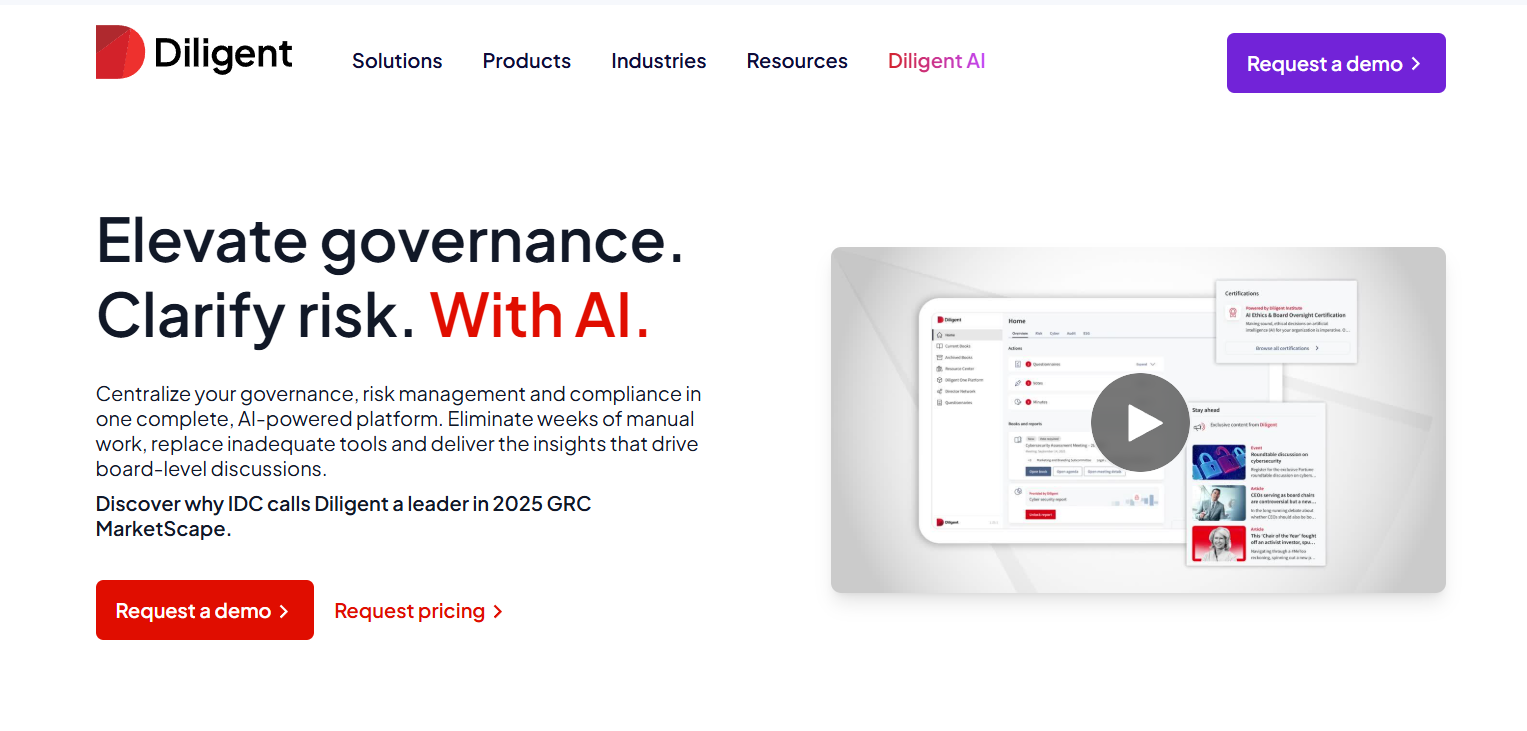
Diligent is a unified GRC system that brings together risk management, audit, compliance, and governance into one centralized platform.
It delivers real-time dashboards, automation, and templated workflows across modules for boards, governance, risk, and audit.
Key features

- Data automation & workflow triggers - Automates evidence collection, alerts, bots, and task reminders to streamline operations.
- Prebuilt libraries & templates - Offers compliance frameworks, risk libraries, and analytics scripts for rapid deployment.
- Executive dashboards - Real-time risk profiles and audit insights curated for board and leadership reporting.
Pricing
There’s no official information on Diligent’s pricing plans.
You can request a custom quote from its sales team or read our Diligent pricing breakdown.

Pros & Cons
✅ Rich template library to help you get started.
✅ Strong reporting features.
❌ Complex onboarding and steep learning curve.
Your next step toward smarter compliance
Choosing the right Compliance AI alternative in 2025 comes down to finding a platform that not only monitors regulatory changes but also gives you full control over your entire GRC program.
While Compliance AI delivers strong regulatory intelligence for financial institutions, many organizations need a broader, more flexible solution that connects risk, compliance, audit, vendor management, privacy, and resilience into one streamlined workflow.
From established enterprise tools like ServiceNow, Archer, and MetricStream to agile platforms like Hyperproof and LogicGate, there’s no shortage of capable competitors.
But if you want a solution that balances comprehensive GRC coverage, real-time collaboration, powerful automation, and no-code flexibility - without the heavy price tag or complexity - SmartSuite stands out.
With SmartSuite, you can centralize all your GRC activities, customize workflows to fit your exact needs, and get started fast with ready-made templates.
And with transparent pricing (including a free plan) and no-code setup, you can hit the ground running without lengthy deployments or hidden costs.
Start your free trial today and see how SmartSuite can help you simplify compliance, reduce risk, and keep your entire team aligned.
Read more
- SAI360 Pricing: Is It Worth It In 2025? - Get a clear breakdown of SAI360’s 2025 pricing, features, and value to see if it’s the right fit for your GRC needs.
- 10 Best LogicManager Alternatives for GRC in 2025 - Explore the top LogicManager competitors this year, from agile no-code tools to enterprise-grade GRC platforms.
- Top 10 ServiceNow Alternatives and Competitors in 2025 [Updated April] - Discover the best ServiceNow replacements for teams seeking more flexibility, lower costs, or industry-specific features.
- SolarWinds Pricing: Is It Worth It In 2025? [Reviewed] - Unpack SolarWinds’ pricing structure and capabilities to decide whether it’s worth the investment in 2025.
- 10 Best ZenGRC Alternatives & Competitors In 2025 - Compare the leading ZenGRC alternatives to find the platform that best matches your compliance, audit, and risk management goals.
- 10 Best Riskonnect Alternatives For GRC In 2025 - See which Riskonnect competitors offer the scalability, automation, and features your GRC program needs to thrive this year.

Run your entire business on a single platform and stop paying for dozens of apps
- Manage Your Workflows on a Single Platform
- Empower Team Collaboration
- Trusted by 5,000+ Businesses Worldwide















